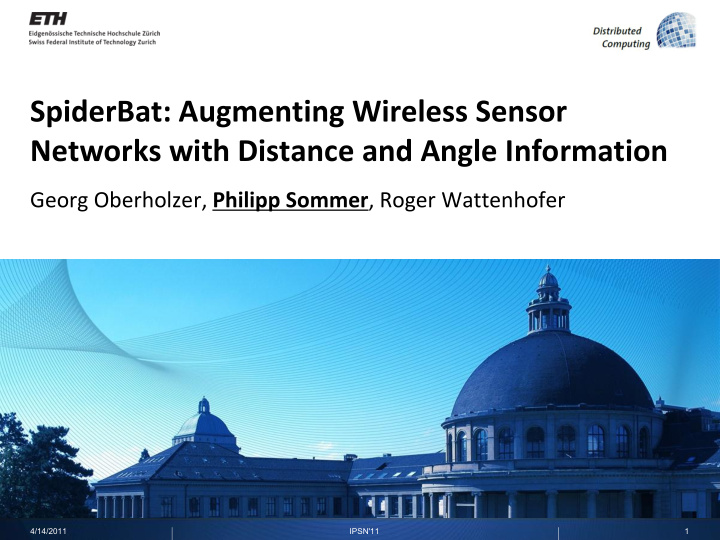



SpiderBat: Augmenting Wireless Sensor Networks with Distance and Angle Information Georg Oberholzer, Philipp Sommer , Roger Wattenhofer 4/14/2011 IPSN'11 1
Location in Wireless Sensor Networks Context of sensor readings <location, time, value> Leverage location information Alice Network layer: geographic routing Physical layer: transmission power control Bob Learn about the current node position Nodes might be attached to moving objects 4/14/2011 Philipp Sommer @ IPSN'11 2
Learning the Position of Sensor Nodes Global Positioning System (GPS) Not for indoor applications Special hardware required High power consumption Radio-based (connectivity/signal strength) High node density required Limited accuracy (multipath effects) 4/14/2011 Philipp Sommer @ IPSN'11 3
Positioning with Ultrasound Inspired by nature ... 20 – 120,000 Hz Human hearing range: 20 – 20,000 Hz
Ultrasound meets Sensor Networks High accuracy Speed of sound c = 343 m/s TelosB/Tmote Sky MicaZ/IRIS Clock speed 32 kHz 1 MHz Resolution 1.04 cm 0.343 mm Low complexity Simple analog circuits for signal processing and peak detection Energy efficiency Short pulses (e.g. 250 microseconds) Duty-cycling ultrasound transmitter/receivers 4/14/2011 Philipp Sommer @ IPSN'11 5
Related Work Cricket [Priyantha et al., 2000] Calamari Medusa [Savvides et al., 2001] [Whitehouse et al., 2004] 4/14/2011 Philipp Sommer @ IPSN'11 6
Ultrasound Ranging Time difference of arrival (TDoA) between radio and ultrasound: 1. Radio packet wakes up ultrasound receivers 2. Ultrasound pulse is sent after a constant delay Sender Receiver t 4/14/2011 Philipp Sommer @ IPSN'11 7
Distance based Positioning in Sensor Networks Determine position based on distances to anchor nodes (trilateration) 3 anchor nodes 4/14/2011 Philipp Sommer @ IPSN'11 8
Positioning in Sparse Networks How does angle information help to position nodes? 3 anchor nodes 1 anchor node 4/14/2011 Philipp Sommer @ IPSN'11 9
The SpiderBat Ultrasound Platform 4x Ultrasound Receivers @ 40 kHz 6.5 cm (2.56 inches) 4x Ultrasound Transmitters Digital Compass @ 40 kHz 4/14/2011 Philipp Sommer @ IPSN'11 10
System Architecture SpiderBat is an extension board for wireless sensor nodes 4/14/2011 Philipp Sommer @ IPSN'11 11
Ultrasound Receiver Circuits Three amplification stages with a total gain of 58-75 dB Each receiver provides two output signals: 1. Digital comparator output generates an interrupt signal (RX_INT) 2. Analog signal output (RX_ADC) 4/14/2011 Philipp Sommer @ IPSN'11 12
Experimental Evaluation Prototype Hardware SpiderBat extension board Atmel ZigBit900 (Atmega1281 MCU + RF212 radio) Software Ultrasound ranging application implemented in TinyOS 2.1 Distance/angle/compass information forwarded to a base station 4/14/2011 Philipp Sommer @ IPSN'11 13
Accuracy of Distance Measurements Measurement errors are in the order of a few millimeters Std. dev of error is 5.39 mm (0.21 inch) at 14 m (45.9 feet) 4/14/2011 Philipp Sommer @ IPSN'11 14
Angle-of-Arrival Measurements with SpiderBat Receiver Sender West South North East Tn Te,Tw Ts 4/14/2011 Philipp Sommer @ IPSN'11 15
Angle-of-Arrival Estimation We can calculate the angle based on the TDoA at the receivers 4/14/2011 Philipp Sommer @ IPSN'11 16
Accuracy of Angle Measurements Estimation of the angle-of-arrival within a few degrees Error is less than 5° for short distances between sender and receiver 4/14/2011 Philipp Sommer @ IPSN'11 17
Indoor Experiments 4 nodes placed in a gym hall, single anchor node (Node 1) 200 measurements for each node Anchor Anchor Step 1: Distance + angle to nearest neighbor Step 2: Minimize distance errors (method of least squares) Std. dev. < 15.5 cm (6.1 inch) Std. dev. < 5.7 cm (2.2 inch) 4/14/2011 Philipp Sommer @ IPSN'11 18
Non Line-of-Sight Propagation What if the direct path between two nodes is obstructed? Node 1 Node 2 Two nodes are in line-of-sight if: 4/14/2011 Philipp Sommer @ IPSN'11 19
Non Line-of-Sight Propagation We use the digital compass to get the node orientation Magnetic North Angle of arrival Honeywell HMC6352 We can use the digital compass to identify non-line of sight paths 4/14/2011 Philipp Sommer @ IPSN'11 20
Outlook: Learning about the Proximity of Nodes Sampling the received ultrasound signal Idea: Identify reflection at nearby obstacles 4/14/2011 Philipp Sommer @ IPSN'11 21
Conclusions SpiderBat platform Ultrasound extension board for sensor nodes Distance and angle measurements Digital compass Experiments Std. dev. of localization error below 5.7 cm (indoor setup) Non-line of sight propagation Detect obstacles between nodes 4/14/2011 Philipp Sommer @ IPSN'11 22
Recommend
More recommend